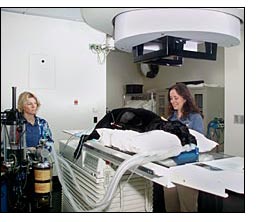ITHACA, N.Y., Dec. 22 -- After years of making his contribution to humans, Brando, a nine-year-old Labrador retriever, has found that it's their turn to return the favor. Brando served for many years as the trusted guide dog for Nancy Moore in Albany. About a year ago, he retired from guiding and returned to live a life of leisure with his breeders, Dick and Bette Jayne Spinney, in Stanford.

(Photo: Alexis Wenski-Roberts/Cornell University Copyright © Cornell University)
Last month, Bette Spinney noticed that the dog's balance was off kilter and that he seemed to have trouble seeing. Brando was brought to Cornell University's Hospital for Animals, where Thomas Kern, chief of ophthalmology in the College of Veterinary Medicine, confirmed that Brando was, indeed, having vision problems: He was blind in one eye. Kern ordered a magnetic resonance image, or MRI. The MRI system at Cornell, built by Esaote of Italy, is North America's first permanent, open-magnet MRI system specifically designed for companion animals -- dogs, cats and other small pets. The system was installed just before Thanksgiving, and Brando was among the first to use it.
The system, which images soft tissue in detail, clearly showed Brando's problem -- a small tumor impinging on the optic nerve.
"Thanks to the new MRI, we were able to diagnose the tumor at this early stage. Catching it early bodes for a better prognosis," Kern said.
"Brando is a lucky dog," said Rod Page, director of the veterinary college's Sprecher Comparative Cancer Institute. "The new imaging technology, coupled with his owner's intuition, probably saved Brando's life, as the tumor could have quickly grown and caused his death."
Because of its location, the tumor is inoperable. However, Cornell is home to a state-of-the-art nuclear accelerator that can be finely tuned for radiation therapy in small animals. Margaret McEntee, the veterinary college's chief of oncology, suggested a three-week course of radiation to try to shrink the tumor. The Spinneys immediately agreed.

Retired guide dog Brando receives radiation treatment from technicians Jean Spencer and Laura Hobbs in Cornell's linear accelerator facility. (Photo: Alexis Wenski-Roberts/Cornell University Copyright © Cornell University)
Radiation treatment began Dec. 6. Every weekday since then, Brando has been showing up wearing a jingle-bell collar and spreading smiles as he enters the veterinary hospital's waiting room.
"Even though we are here for an unhappy reason, we can still have some holiday cheer. The collar jingles give everyone a bit of a lift," said Bette Spinney.
After the first week of treatment, she observed that Brando's balance had improved and that he was more active and able to climb stairs again. Ophthalmology resident Eric Ledbetter took a closer look at Brando's eyes and concluded that the optic nerve indicated a return of function.
On Christmas Eve morning, Brando will receive his last daily radiation treatment and return home for the holidays. And just as an angel gets its wing with each jingle of his collar, there is a retired guide dog that will soon see again.
For more information, visit: www.news.cornell.edu